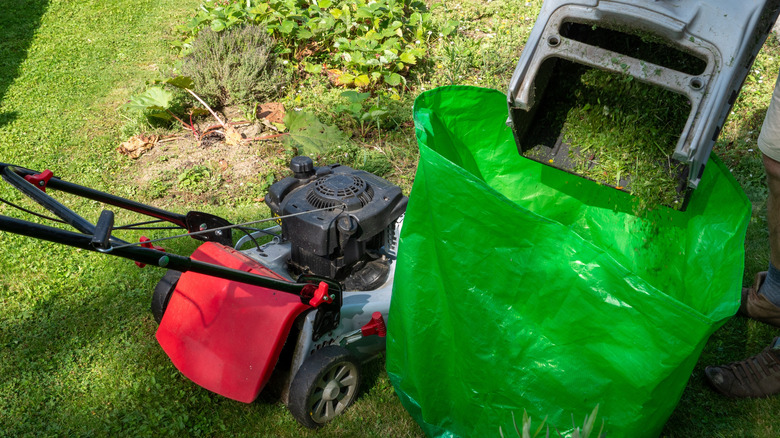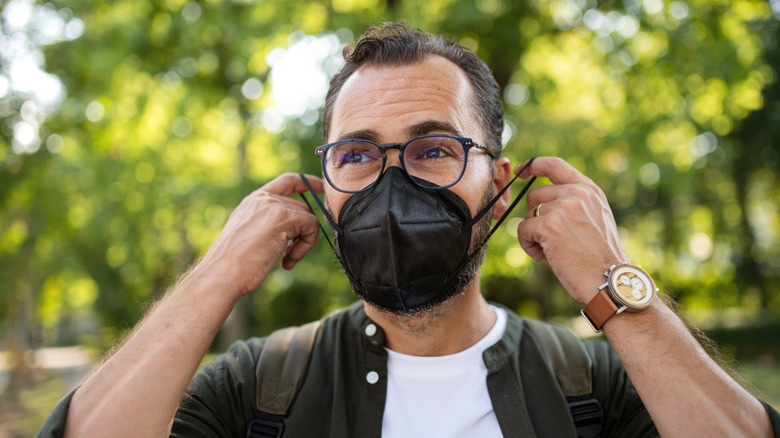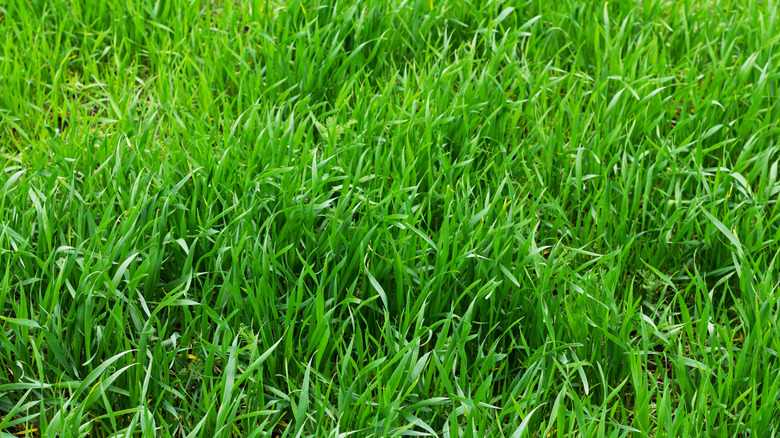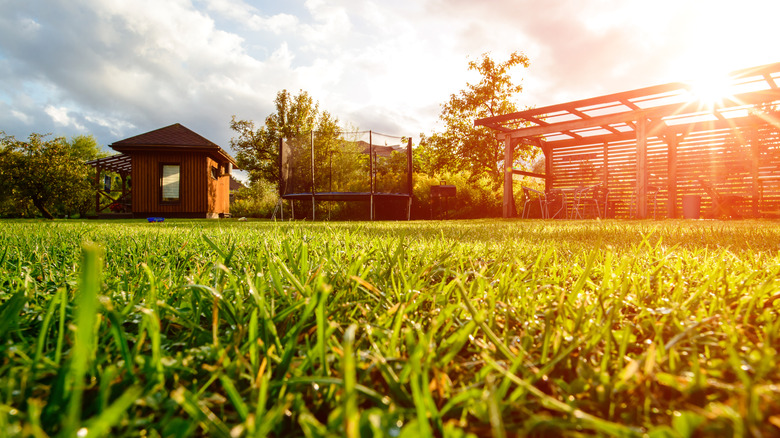Mistakes You Make When Mowing The Lawn That Are Seriously Triggering Your Allergies
We may receive a commission on purchases made from links.
Do your seasonal allergies feel like they are getting worse every year? It's not just your imagination. As global temperatures rise, winters become shorter and the growing season becomes longer. In a study published by the National Academy of Sciences, pollen season rose by 20 days from 1990 to 2018, and pollen concentrations grew by 20% thanks to an increase in atmospheric carbon dioxide. In short — you're feeling worse for longer.
With more jobs going remote, there's also been a mass exodus from big cities to more rural environments, so a lot of people may be experiencing seasonal allergies for the first time (just when you thought you were fleeing the smog for fresher air). If you deal with allergies, you may want to hide in the house until the misery ends. However, spring is the best time to enjoy the outdoors, and it's also when you need to do the most yard work. You take great pains to keep your yard healthy, and how does it repay you? With a runny nose and itchy eyes.
One unavoidable outdoor task is mowing the lawn. You may be making mistakes while mowing that are seriously triggering your allergies, like leaving your grass clippings lying around or letting your grass grow long. Avoid this list of common mowing mistakes, and you may have a less sniffly spring.
Leaving the grass clippings
If you thought pollen was only the yellow stuff that falls from trees and stains your deck, think again. Grass also contains pollen, and from April to June, it is the number one cause of allergy symptoms. Only some of the hundreds of grass types cause allergies, but those that do include common grass types like Fescue, Kentucky Blue, Bahia, and Bermuda. Even if you have one of the hypoallergenic grasses, your lawn is probably filled with fallen pollen from nearby trees and plants, and mold spores from decaying plant matter. Grass clippings are covered in these allergens, and leaving them on the ground can cause a major allergy or asthma attack.
The best solution is to use a mower with a bag that catches the clippings, like this well-reviewed mower from the American Lawn Mower Company. Otherwise, you can use a trick to bag grass clippings easily after raking them into a pile. If you're prone to allergies, bagging is a better option than mulching, which just returns the stirred-up grass pollen to your yard. Leaving your grass clippings on your lawn also looks messy and provides a hiding spot for pests, so there are added benefits to bagging. The one con is having to dispose of the clippings. If you don't live in a state that picks up yard waste from your home, you will need to transport it to a yard waste recycling facility.
Not wearing a mask
All of that pollen doesn't just sit nicely on the ground waiting to be bagged, but gets thrown through the air while mowing. Wearing a mask and protective eyewear while mowing will offer tremendous relief to allergy sufferers and those with respiratory illnesses like asthma. Since pollen likes to stick to hair, you should also consider wearing a hat or hair covering.
Even if you don't suffer from allergies, it's a good idea to cover your face while mowing. Mowing can kick up all kinds of dust and debris like pebbles, rocks, and insect parts that come flying at your face and eyes. Still not convinced? You could mow over a dead animal, which can lead to contracting diseases like rabies, avian flu, and Tularemia (tularemia deaths from mowing over dead animals have been reported). This RANKSING Respirator Mask with filters and safety glasses is a good combo, but if you are worried about what the neighbors might think, you can go for a bandana/sunglasses combo. It won't provide the same level of protection, but it's better than nothing.
Waiting too long to mow
If mowing your lawn exacerbates your allergy symptoms, you may think it wise to put off mowing as long as possible. However, the opposite is true. The more often you mow, the milder your symptoms will be. This is because tall grass is more likely to release pollen into the air, making it worse for you while mowing or even when you're simply hanging out in your yard. The right length to mow your lawn if you are an allergy sufferer is 2 inches. This cuts the grass off before it can flower and pollinate, and is the recommended lawn height of the Asthma and Allergy Foundation of America (AAFA) and lawn care companies.
You may have heard the terms "No Mow May" and "Mow Tall Until Fall," which advocate letting grass grow long to improve your lawn's health and attract pollinators. These steps can be beneficial, but if you are an allergy sufferer, it's best to keep your grass short. There are other ways to keep your lawn healthy and happy, and you can bring more bees into your yard by planting native wildflowers that are both bee- and allergy-friendly.
Mowing at the wrong time
Picture this: It's Saturday, and you need to mow the lawn. Today will be another scorcher, so you've decided to mow in the morning before it gets too hot and before you've showered for the day. Of course, being the weekend, you'd like to sleep in a bit, and you don't want to be a bad neighbor by mowing too early. Mid-morning seems to be the ideal time for this weekly chore. Sounds perfect, right? Well, not really. If you suffer from hay fever and seasonal allergies, that's the worst possible time to mow. Plants release pollen overnight and again in the morning, and around 10 am is when pollen levels peak. In the late afternoon and early evening, pollen levels are typically lower, and that's the best time to mow your grass.
With busy schedules and unpredictable weather, you may not have time to choose the perfect allergy-friendly day to mow. But if possible, choose a rainy, cloudy day with no wind, which are the best days for allergy sufferers (as a bonus, they provide shelter from the heat). Those with extreme symptoms should consider checking the local pollen count daily with an app like Pollen Wise, which can tell you the worst and best days of the week for yard work.
Not washing off after mowing
Pollen and mold spores can stick to your hair, body, and clothes after mowing the grass. To keep allergy symptoms at bay, wear outdoor boots you can leave on the porch, throw your mowing clothes directly into the washing machine, and take a shower immediately after mowing. Until you do so, you'll be inhaling allergens and spreading them throughout your house. You could spread pollen to your favorite armchair, making your safe space just as allergy-prone as the outdoors. The AAFA recommends taking these steps not just after mowing, but after spending any significant time outside during pollen season.
And don't forget about pets. Tree, grass, and weed pollens can easily get stuck on pet fur and hair. Bathe pets regularly, and wipe them down after they've spent time outside. Other ways to keep the inside of your home free of outdoor allergens is by keeping windows and doors closed, and cleaning your home regularly.





